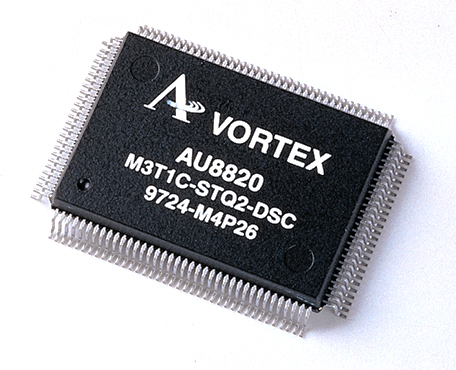Real World Audio
Acoustic bliss--an interactive, real-life audio experience by surrounding the listener with sounds in three dimensions using only a single pair of ordinary speakers or headphones. Getting an earful earns an entirely new and enjoyable meaning thanks to the audio know-how of Aureal Semiconductor, Incorporated of Fremont, California, and its subsidiary, Crystal River Engineering (CRE), Incorporated of Palo Alto, California.
"We hear the future" is a behind-the-scenes slogan that drives the work. That spirit to advance audio technology was initially spurred by CRE's work in collaboration with the Spatial Auditory Displays Laboratory at the Ames Research Center. Very high-speed digital audio processing systems were developed to further Ames' research on virtual acoustic displays, part of the center's broader investigation into virtual reality and advanced multimedia displays for aviation and space applications. The NASA objective was to explore the possibilities of combining a three-dimensional (3-D) auditory system with visual virtual displays.
Aureal develops and markets a line of products that incorporate 3-D sound into video games, surround sound systems, computer sound cards, Internet sites, and other interactive software applications.
By furthering what is termed psychoacoustic research, audio standards have been raised to new dimensions. Aureal has embraced this research, creating innovative technology that alleviates the need for pre-encoding sounds or adding extra speakers to achieve "virtualized" experiences. The 3-D audio technology enables interactive placement of sounds in the entire 3-D space surrounding a listener. The advantage is obvious: A new generation of audio experience that is interactive, immersive, and fully three-dimensional.
Audio accelerators, for instance, can turn a computer into a thundering, true-to-life sound machine equal in quality to home theater surround sound systems. The result is a transformation of game playing into a visual and audio romp, immersing the user in a more interactive experience.
The interactive 3-D audio technology can be heard on the Internet. By using virtual reality modeling language browser software, Internet surfing now includes exploring 3-D websites. A user can be totally immersed in 3-D worlds, both visually and acoustically. As the user travels around a three-dimensional environment, sounds are rendered in their true locations with respect to the user. For example, if a virtual person is standing behind a user in a world, the person's voice will sound like it is projected from behind and will travel around the side and to the front as the user turns to face it.
Even a virtual sing-along, Karaoke style, has been introduced using the advanced audio effects technology. An effects processor chip offers voice pitch shifting, vocal accompaniment and vocal track elimination, among its functions. Fun vocal effects are also available, as is an application for people who are not comfortable singing in their own voice but prefer to amaze an audience with the warbling of a virtual singer.
Top software developers are enthusiastically embracing the 3-D audio technology to maintain an edge of competitors. Already signed up are such software companies as Acclaim, Activision, Electronic Arts, Epic, and LucasArts. The first titles using the audio advancement have reached store shelves, with dozens more in production. Technology licensing of the three-dimensional audio enhancement has permitted its use in an array of multimedia products offered by such developers as Analog Devices, ATI Technologies, Cirrus Logic, Diamond Multimedia, S3, Oak Technology, and Rockwell International.
Aureal has been able to bring 3-D audio from NASA's high-end research work in jet cockpit displays and flight simulators to mainstream electronic entertainment, consumer electronics, and communication applications. Applying that research has brought a level of awareness, realism, immersion, and engagement to the user, once only possible in real-life situations. By enveloping a listener in a three-dimensional sound field, a user is no longer aware of the audio system that is rendering the sounds.
Indeed, a new level of audio experience...and a sound investment in the future.

A high-speed digital audio processing system enables three-dimensional sound to be used in numerous consumer products, from computer games to home entertainment equipment.













